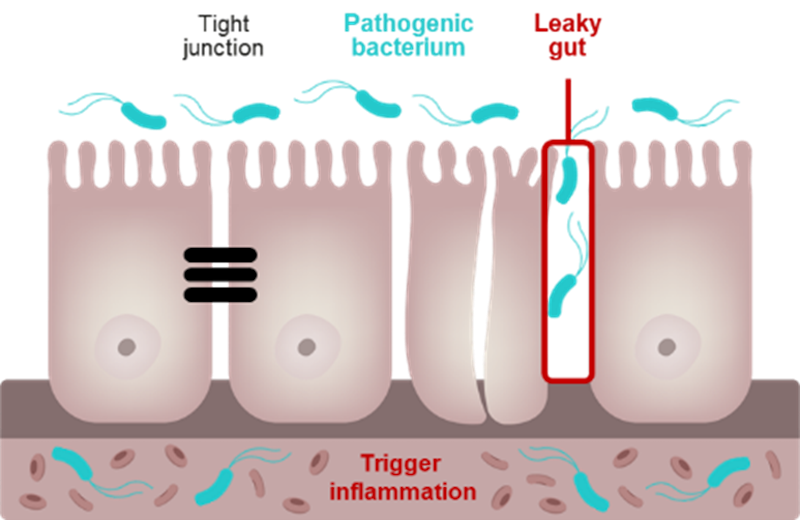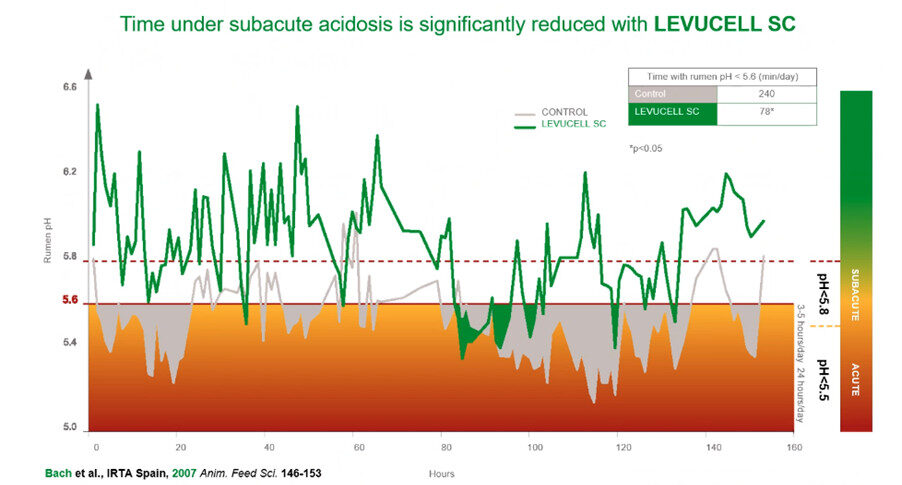Ketosis, reproductive challenges and poor peak milk yield… Is ‘leaky gut’ to blame?
The answer is yes, leaky gut can play a significant role in all three. But how are they linked and what does it mean for you on farm? To answer this question, we first need to take a step back and understand what the rumen and intestine are meant to do in the first place.
Leaky rumens and leaky intestines
The rumen and intestinal walls are designed to be selective – i.e. only let through what they should. What is floating around in the digestive system is technically still the ‘outside’ of the body – the animal must absorb nutrients using channels and gateways to ensure that only the ‘good stuff’ comes into the bloodstream. However, when we have inflammation or damage to the rumen or intestine wall, this barrier becomes disrupted which allows bacteria and other substances through that trigger an immune response.

Figure 1: Black lines are tight junctions that hold the barrier closed. Blue are pathogenic (disease or immune-response causing) bacteria. Leaky gut lets these pathogenic bacteria into the bloodstream, triggering an immune and inflammatory response.
Why does an immune response matter?
The immune system and inflammation responses take priority – that’s survival for the cow (or any ruminant animal). So once that immune system is activated it takes glucose away from everything else.
For a dry cow with leaky gut this may mean less glucose for body condition gain, or importantly, less glucose to repair and establish ‘milk making cells’ in the udder. This can then flow into a slow or low peak milk yield once she calves as there are less milk making cells. Therefore, protecting the rumen and gastro-intestinal tract from damage is critical for dry cows and springer cows as it can affect milk production for the entire lactation.
The immune response to leaky gut also matters for milking cows as glucose makes lactose which drives milk volume. For every litre of milk produced approximately 72 g of glucose is required. If the immune system is activated by leaky gut, then less glucose is available for milk.
The flow on effects can then become significant with less glucose affecting reproduction, feed intake and ketosis risk¹

¹Horst, S.K. Kvidera, L.H. Baumgard (2021). Invited review: The influence of immune activation on transition cow health and performance—A critical evaluation of traditional dogmas. Journal of Dairy Science, 104(8) 8380-8410
Note that leaky gut is not just a problem for those feeding higher levels of supplementary feed. Rapid rumen throughput of lush leafy pasture can mean our New Zealand cows are at a very high risk of sugars and starches rapidly dropping rumen pH and damaging the rumen wall. Fast-transit also risks starches and sugars overflowing into the intestine, increasing the risk of hindgut acidosis and ‘leaky intestines’.
What does this mean for you on farm?
If ‘leaky gut’ is the start of the problem, then the focus on farm needs to be how to prevent leaky rumens and leaky intestines.
Some places to start preventing leaky gut include:
- Establish strong tight junctions – Levucell®SC and Levucell®SB live yeasts are proven to increase activity of tight junctions and reduce inflammatory markers²‚³. In a study by Bach et al (2018), the supplementation of Levucell®SC before calving helped the rumen wall better prepare for the stress encountered around calving, improving rumen wall integrity and increasing resistance to rumen wall inflammation. This is peer reviewed, published Journal of Dairy Science research.
- Stabilise rumen pH – There are a range of solutions in the Nutritech Rumen Health Toolkit including AcidEase®, RumenBuf®, Levucell®SC and Levucell®SB. These are well established feed additives that help stabilise rumen pH and reduce the effects of sub-acute rumen acidosis (SARA) and hindgut acidosis.
- Manage dry cow and springer transitions – Avoiding gorging behaviour (for example tight pasture breaks for dry cows). High fibre forages are useful to help dry cows feel physically full even when on lower daily dry matter intakes. Smoothing diet changes also helps reduce sudden drops in rumen pH.
- Take a closer look at the diet – Physically effective fibre (peNDF), starch and sugar content, potential acid loading (PAL) can all be checked using Diet Check ration balancing software with your local Nutritech Area Manager. Manure sieves and particle separators also give us a physical check of the feed and fibre digestion.
²Bach A, Guasch I, Elcoso G et al., (2018). Changes in gene expression in the rumen and colon epithelia during the dry period through lactation of dairy cows and effects of live yeast supplementation. Journal of Dairy Science 101(3):2631-2640
³Steele, M., & Cangiano, L.R., (2024). Transition dairy cows fed Saccharomyces cerevisiae boulardii CNCM1-1079 show better resilience and performance as a potential indirect effect of lower gut health. Presented at the American Dairy Science Association (ADSA) Conference 2024.
5. Reduce toxin loading – Another approach is to use specific yeast derivatives such as mannan-oligosaccharides (MOS) which can help with supportive binding capacities to reduce the load of toxins that can pass through the gut walls. These yeast derivatives interact directly with immune cells, eliciting a local and systemic immune response. They can also interact with undesirable bacteria and help prevent their attachment and colonisation of the gastrointestinal tract. AgriMOS® or FusionDYAD® are good options for this purpose.

Leaky gut, SARA or hindgut acidosis signs to watch out for:
- Slow drive to peak or a low peak, even though you are feeding them well.
- Elevated SCC
- Manure that is either:
- Loose – low ruminal pH can draw water in
- Bubbly – the rumen isn’t working so the intestine does all the fermenting
- Undigested feed particles – rumen / intestine isn’t functioning
- Presence of mucous or intestinal lining in faeces – intestinal damage
- Lameness challenges (especially white line and laminitis)
- Cyclical eating or reduced feed intake – individual cows may be interested one day, not the next.
- Depressed milk fat %
- B1 deficiency in calves
For more information on this topic, reach out to your local Nutritech Area Manager.

